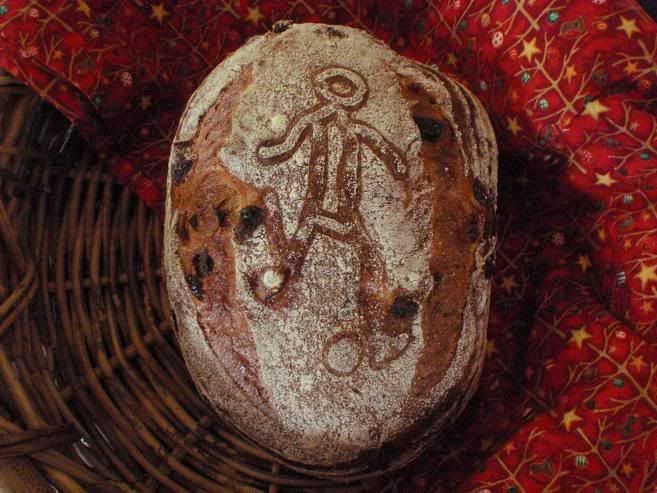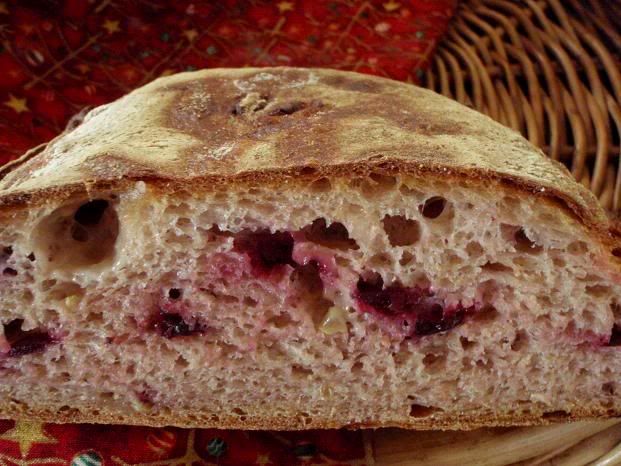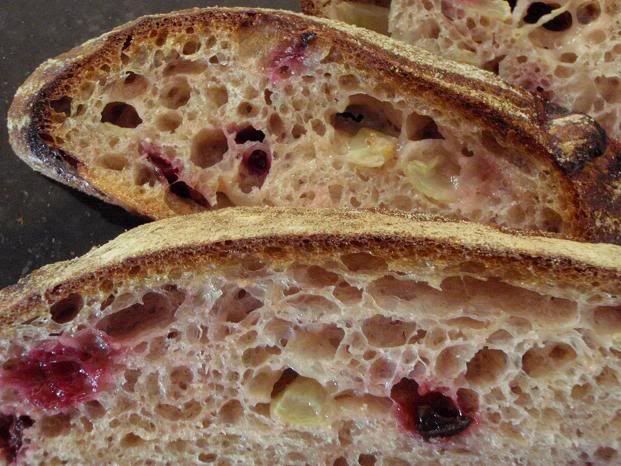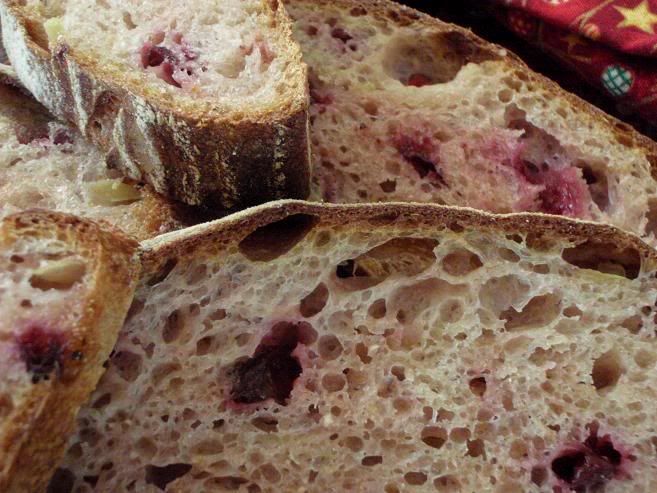What do you do when you bought the wrong grapes and your children and house guests don't eat them? I don't mind the odd seeds in the grapes; I chew them and swallow them. They are good for you. Plenty of anti-oxidant in the grape seeds! But do you think I can get my family to eat these beautiful grapes?
Holiday seasons at our household seem to come with endless sessions of drinking every day. When the sun is setting and the western sky is showing multiple rosy hues, it's time to have a dip in the pool and put on fresh clean clothes for the nightly drinks. The housewife of this household is ever ready to put on an Hors d'œuvre or two to go with the wine.
Grapes are the best friend to accompany cheeses. So as the succulent juicy cherries! How often do you get to eat them? I don't know about you, but where I come from, cherries are decadent. After many years of draught in Queensland (Australia), we have just had a bumper year of rain. The draught seems to have broken. What seemed to be expensive fruits in prior years are now very cheap.
Anyway, the long and the short was I had too much of grapes and cherries in my household. So what did I do? I made them into a fresh grapes and cherries sourdough:

My son had her girl friend visiting for the day. The shape of the sourdough is for him but the taste combination is for her. I used a brotform that I have which has a boy playing soccer engraved on the bottom of the basket to get the stencil effect on the crust.

Unfortunately, cherries and grapes sourdough is not a boy's thing. My son didn't like it. But both his girl friend and I loved it. She said it is very "springy," and she is right.

The making of this pain au levain was a bit tedious but I enjoyed it.
(1) First, I pureed 1/2 kg of non-seedless [b][color=purple]purple grapes[/color][/b] (skin, seeds, and all), put the pulp through a fine sieve and got 345 grams of grape juice. I let this stand overnight along side my starter which was refreshed. (I secretly hoped that some yeasts might develop out of the grape juice. A long while ago I cultured a grape starter. It was very powerful. I had to put it to sleep by making it into dry powder. I haven't used it since.)
(2) I took the stones out of 160 grams of cherries and got 145 grams of small diced pieces.
(3) I chopped up 160 grams of [b][color=green]green seedless grapes[/color][/b].
(4) The next morning, I was ready to mix the dough. I had a sip of the grape juice and found that it was too sweet to use all of it. Too bad. I had wanted to use it to color my dough. The little beasties in my starter might drawn and die of thirst if I used all of it; who knows. I ended up using only 200 grams.
(5) I aimed for a dough of 65% overall hydration [b]before[/b] the fresh fruits were added. Once the fruits were incorporated, the overall dough hydration would increase as some liquid would be squeezed out during the mixing and folding.

[b][u][color=purple]Here is my list of ingredients [/color][/u][/b]:
- 338 g ripe 60%-hydration starter
- 50 g medium rye flour
- 100 g whole wheat flour
- 553 g bread flour
- 267 g water
- 18 g salt
- 200 g purple grape juice (as above)
- 145 g diced cherries (as above)
- 160 g diced green seedless grapes (as above)
Total dough weight was 1830 g and the overall dough hydration felt like 72 - 73%. ([b][color=red]Note[/color][/b]: if your starter is 75% or 100% hydration, reduce water to 237 g or 198 g, respectively.)
- Mix all ingredients except the fruits. Autolyse 30 minutes.
- First set of stretch and folds of 20 - 30 strokes. Rest 30 - 45 minutes.
- Spread 1/2 of the cut fruits on a work bench, stretch the dough to cover the fruits, then top the dough with the remaining fruits. Fold the fruits into the dough with a plastic scraper or by hand (50 - 60 strokes).
- Rest 30 minutes. As some liquid is squeezed out of the fruits, the dough is now wetter and may require two more stretch and folds of at least 30 - 40 strokes for further dough strength.
- The rest of the procedure is standard. (As my room temperature was warm, total fermentation time was slightly less than 4 hours. I retarded the shaped dough overnight in the fridge and baked it the next morning.)
I recognized something very similar in the crumb structure of this bread as in the Pain au Levain with Praline Rose that I did in mid October. I think the presence of a relatively high level of sweetness in both cases resulted in very open interior structure. The little yeast beasties really liked what I fed them in the final dough. They were able to digest the foods (the sugar) and, you know what, the bread did not taste sweet at all! In fact, this bread tastes pleasantly sour (apart from being very "springy;" i.e., chewy, as my son's girl friend said). This sourness to me is not like the normal acidity that we get in a very sour dourdough. It is different from when we say a Miche is sour. To me it is halfway in between lactic acidity and fruity sourness.
(Where has the sugar gone?)
Shiao-Ping
- Shiao-Ping's Blog
- Log in or register to post comments
You are teasing us with this delectable looking master piece! It makes my mouth water.....
I can not wait to see what you have in store for the coming New Year...!
Judd
Thank you for the recipe and photos. Cherries are one of my favorite fruits. The boule looks so gorgeous, colorful and tasty.
We also had a fantastic sweet cherry season in California last summer. I just wish we could get the fresh tart cherries.
Sylvia
Very nice Shiao-Ping. It looks moist and desert like. I'll bet a bread pudding made with this would be outstanding.
Eric
... using the left-over fruit bread/fruit sourdough to made Bread and Butter Pudding! I've tried similar things before and my husband really like it.
love cherries! and eric's right, they would be nicely ensconced in a very moist bread pudding. glad the girlfriend and you agree on the bread - sign of things to come?
... and because it's a lot drier and harder to dilute in water than my old starter, I think I hurt my right wrist constantly having to use strength to do it. Last night my husband was diluting my starter for me, he broke a wooden spoon! This is how hard trying to dilute a big portion of a stiff starter! He said that he's glad that he is left handed, that way at least his right hand will not be sore! Aussie humour.
Shiao-Ping,
Hello. Could you please tell me your baking method that you achieve such a great looking loaf? What type of oven are you using? Thanks. Jim.
My oven is a nearly 20-year-old, very standard, home oven. It is a convection, fan forced oven and has a timer. It does not have a separate top or bottom element, just one heat.
(1) When I pre-heat my oven, I turn it full on, as high as it goes (maybe 250 or 260 degree C) for one hour at least.
(2) When the dough is loaded, I pour one cup (not more, just one cup) of boiling hot water on the lava rocks sitting in a roasting pan on the bottom of the oven, lots of steam will generate immediately, then I quickly shut my oven door (which incidentally does not close tight, some steam escapes from the side of the door).
(3) Once the oven door is shut, straight away, I turn the heat down to 230 C or whatever is specified in the formula.
(4) After the first 10 to 15 minutes of baking, I put on my oven mit and turn the dough around so the dough gets even browning. (This is important for my oven as it does not bake evenly.)
(5) Towards the last 10 minutes or so baking, I'd be watching the dough like a hawk, because I want nice color but I don't want the dough burned. Every oven is different.
Baking is only one part of the story. Making of the dough to me is more important. If you are interested in how the dough is combined with the add-ins (in this case, the fresh fruits, but it can be many things and anything you like), there is a more fuller discussion in my Chocolate Sourdough post.
Having said all that, I find the one key thing in making a good sourdough is how healthy the starter is. One might have great technique, but if the starter doesn't coorporate, there won't be great sourdough!
Shiao-Ping,
Thanks so much for responding to my question! I recently gained access to a home oven that has both standard and convection settings, and am excited that I have the possibility of learning to use the convection method. I am in total agreement with you that the making of the dough is "all-important" . . . like-wise the starter. I am on day 3 of my Desem starter, and I believe everything is going as it should. In "The Laurel's Kitchen Bread Book" (I'm following this method), for Day 3, the first 2 lines state "The top surface of the flour may show a split or crack. Things are happening!". When I lifted the cover off the container today, there were 2 hair-line fractures in the form of a cross, dead center of the flour (it was a religious experience - ha!). I'm using KA's Organic 100% Wheat, and plan to follow these instructions to the letter.
My ultimate goal is to build, and bake from, a wood-fired brick oven. But until that happens, I'm trying to make the most of baking from the home oven. Do you choose the convection method, having both settings available on your oven? Do you believe convection is adding to the end result . . . that you wouldn't achieve quite the same results using radiant heat? And finally, is there a standard rule-of-thumb when converting baking times from standard to convection? Thank you for sharing your skills and knowledge. It is greatly appreciated. Jim
Unfortunately I have never tried the non-convection setting for bread making. They say a set degree in convection is 20 degree C hotter than non-convection setting, but I have never followed that rule. Because my oven is electric, not a gas oven, it seems to take forever to heat up to the required temperature. I do have an oven thermometer but rarely use it; they say you should check the actual temperature, not relying on the dial, before you bake. It will be a good practice if your oven, or WFO, is new to you, until you get familiar with it. Different spots within an oven, like different spots within a refrigerator, may regiester different temperatures. If you do a search at The Fresh Loaf, you may find some information regarding standard vs. convection oven. I believe the important thing is we have to be familiar with how our oven perform. Personally I do believe convection would work better with bread baking because of how ocnvection works.
Most beautiful! You are the newest interest of my few since I've joined...and only a short while.
Thanks for your solid understanding of purest technique. We're new here, like I said, but results like this drive me.
"Purest technique" - I am not so sure about that, but thank you just the same. [color=blue][b]Here[/b][/color] is ONE of the MANY home bakers here at TFL who have the purest technique!
Shiao-Ping